Pathways of Dissipation of Frictional Energy under Boundary Lubricated Sliding Wear of Martensitic Materials
Abstract
:1. Introduction
2. Materials and Methods
2.1. Materials
2.1.1. Carburized Steel 18CrNiMo7-6
2.1.2. Flame-Hardened Cast Iron EN HJS-HB265
2.1.3. Surface Preparation
- milled—leaving a periodic semi-circled surface;
- ground—to decrease the surface roughness after milling;
- milled + finished—to reduce the peak height while preserving the valleys;
- polished—serving as a reference sample.
2.2. Laboratory Tribosystems and Analyses
2.3. Metallography and Microscopy
2.3.1. Light Microscopy and Hardness Measurements
2.3.2. Scanning-Electron Microscopy (SEM)
2.3.3. Transmission Electron Microscopy (TEM)
3. Results
3.1. Friction and Wear
3.2. Wear Appearances
3.2.1. Carburized Steel 18CrNiMo7-6 vs. Carburized Steel 18CrNiMo7-6
3.2.2. Flame-Hardened Cast Iron EN HJS-HB265 vs. 100Cr6
4. Discussion
4.1. Carburized Steel 18CrNiMo7-6 vs. Carburized Steel 18CrNiMo7-6
- Due to the fact that we found no cracks with this tribocouple the breaking mode can be ruled out.
- From [19] we know that shear bands are characterised by extreme grain refinement which would take up the shearing mode, while.
- According to [50] nanocrystalline metals deform under shear by rotation of grains comprising the rotation mode.
4.2. Conclusions of Carburized Steel 18CrNiMo7-6 vs. Carburized Steel 18CrNiMo7-6
4.3. Flame-Hardened Cast Iron EN HJS-HB265 vs. 100Cr6 (CI/BS)
4.4. Conclusions of Flame-Hardened Cast Iron vs. Ball Bearing Steel 100Cr6
5. Limitations
6. Conclusions and Outlook
Acknowledgments
Author Contributions
Conflicts of Interest
References
- Fleischer, G. Energy method of wear computation. Schmier 1973, 4, 269–274. [Google Scholar]
- Uetz, H.; Foehl, J. Wear as an energy transformative process. Metaux. Corros. Ind. 1979, 55, 340–350. [Google Scholar]
- Heilmann, P.; Rigney, D.A. An energy-based model of friction and its application to coated systems. Wear 1981, 72, 195–217. [Google Scholar] [CrossRef]
- Fouvry, S.; Kapsa, P.; Zahouani, H.; Vincent, L. Wear analysis in fretting of hard coatings through a dissipated energy concept. Wear 1997, 203–204, 393–403. [Google Scholar] [CrossRef]
- Fouvry, S.; Paulin, C.; Liskiewicz, T. Application of an energy wear approach to quantify fretting contact durability: Introduction of a wear energy capacity concept. Tribol. Int. 2007, 40, 1428–1440. [Google Scholar] [CrossRef]
- Abdel-Aal, H.A. Influence of frictional energy dissipation on wear regime transition in dry tribo-systems. Int. J. Mater. Prod. Technol. 2010, 38, 78–92. [Google Scholar]
- Rymuza, Z. Energy concept of the coefficient of friction. Wear 1996, 199, 187–196. [Google Scholar] [CrossRef]
- Huq, M.Z.; Celis, J.P. Expressing wear rate in sliding contacts based on dissipated energy. Wear 2002, 252, 375–383. [Google Scholar] [CrossRef]
- Fouvry, S.; Liskiewicz, T.; Kapsa, P.; Hannel, S.; Sauger, E. An energy description of wear mechanisms and its applications to oscillating sliding contacts. Wear 2003, 255, 287–298. [Google Scholar] [CrossRef]
- De Moerlooze, K.; Al-Bender, F.; Van Brussel, H. A novel energy-based generic wear model at the asperity level. Wear 2011, 270, 760–770. [Google Scholar] [CrossRef]
- Hanke, S.; Samerski, I.; Schöfer, J.; Fischer, A. The role of wear particles under multidirectional sliding wear. Wear 2009, 267, 1319–1324. [Google Scholar] [CrossRef]
- Shakhvorostov, D.; Pöhlmann, K.; Scherge, M. An energetic approach to friction, wear and temperature. Wear 2004, 257, 124–130. [Google Scholar] [CrossRef]
- Gane, N.; Skinner, J. The generation of dislocations in metals under a sliding contact and the dissipation of frictional energy. Wear 1973, 25, 381–384. [Google Scholar] [CrossRef]
- Jost, N.; Schmidt, I. Friction-induced martensitic transformation in austenitic manganese steels. Wear 1986, 111, 377–389. [Google Scholar] [CrossRef]
- Oila, A.; Bull, S.J. Phase transformations associated with micropitting in rolling/sliding contacts. J. Mater. Sci. 2005, 40, 4767–4774. [Google Scholar] [CrossRef]
- Cao, S.; Sarasin, F.; Cantoni, M.; Mischler, S. Effect of surface films on tribologically induced metallurgical transformations of steel in oil lubricated contacts. Wear 2016, 368–369, 75–83. [Google Scholar] [CrossRef]
- Saleski, W.J.; Fisher, R.M.; Ritchie, R.O.; Thomas, G. The Nature and Origin of Sliding Wear Debris from Steels. Available online: https://cloudfront.escholarship.org/dist/prd/content/qt7t1779pp/qt7t1779pp.pdf (accessed on 3 April 2018).
- Fischer, A.; Weiss, S.; Wimmer, M.A. The tribological difference between biomedical steels and CoCrMo-alloys. J. Mech. Behav. Biomed. Mater. 2012, 1, 50–62. [Google Scholar] [CrossRef] [PubMed]
- Rainforth, W.M.; Stevens, R.; Nutting, J. Deformation structures induced by sliding contact. Philos. Mag. A 1992, 66, 621–641. [Google Scholar] [CrossRef]
- Büscher, R.; Fischer, A. The pathways of dynamic recrystallization in all-metal hip joints. Wear 2005, 259, 887–897. [Google Scholar] [CrossRef]
- Stickel, D. The Influence of Surface Finish on the Localized Dissipation of Frictional Power at Ultra-Mild Wear. Ph.D. Thesis, University of Duisburg-Essen, Duisburg, Germany, 2015. [Google Scholar]
- Fillot, N.; Iordanoff, I.; Berthier, Y. Wear modeling and the third body concept. Wear 2007, 262, 949–957. [Google Scholar] [CrossRef]
- Johnson, K.L. Contact Mechanics; Cambridge University Press: Cambridge, UK, 1985; p. 425. [Google Scholar]
- Berns, H.; Theisen, W. Ferrous Materials: Steel and Cast Iron; Springer: Berlin, Germany, 2008. [Google Scholar]
- Goeke, S.; Biermann, D.; Stickel, D.; Stemmer, P.; Fischer, A.; Geenen, K.; Huth, S.; Theisen, W. Enhancing the surface integrity of tribologically stressed contacting surfaces by an adjusted surface topography. Procedia CIRP 2014, 13, 214–218. [Google Scholar] [CrossRef]
- Wimmer, M.A.; Laurent, M.P.; Mathew, M.T.; Nagelli, C.; Liao, Y.; Marks, L.D.; Jacobs, J.J.; Fischer, A. The effect of contact load on CoCrMo wear and the formation and retention of tribofilms. Wear 2015, 332–333, 643–649. [Google Scholar] [CrossRef] [PubMed]
- Bermúdez, M.D.; Iglesias, P.; Jiménez, A.E.; Martínez-Nicolás, G. Influence of sliding frequency on reciprocating wear of mold steel with different microstructures. Wear 2009, 267, 1784–1790. [Google Scholar] [CrossRef]
- Stickel, D.; Goeke, S.; Geenen, K.; Huth, S.; Theisen, W.; Biermann, D.; Fischer, A. Reciprocating sliding wear of case-hardened spheroidal cast iron against 100Cr6 under boundary lubrication. Proc. Inst. Mech. Eng. J. Eng. Tribol. 2015, 229, 1214–1226. [Google Scholar] [CrossRef]
- Stickel, D.; Fischer, A.; Bosman, R. Specific dissipated friction power distributions of machined carburized martensitic steel surfaces during running-in. Wear 2015, 330, 32–41. [Google Scholar] [CrossRef]
- Büscher, R. Gefügeumwandlungen und partikelbildung in künstlichen metall/metall-hüftgelenken. Ph.D. Thesis, Universität Duisburg-Essen, Düsseldorf, Germany, 2005. [Google Scholar]
- Stemmer, P. The divergent pathways and mechanisms of energy dissipation at the interfaces of martensitic tribocouples. Ph.D. Thesis, University of Duisburg-Essen, Duisburg, Germany, 2016. [Google Scholar]
- Dimkovski, Z.; Anderberg, C.; Rosén, B.G.; Ohlsson, R.; Thomas, T.R. Quantification of the cold worked material inside the deep honing grooves on cylinder liner surfaces and its effect on wear. Wear 2009, 267, 2235–2242. [Google Scholar] [CrossRef]
- Czichos, H.; Dowson, D. Tribology: A systems approach to the science and technology of friction, lubrication and wear. Tribol. Int. 1978, 11, 259–260. [Google Scholar] [CrossRef]
- Czichos, H. Overview and Classification. In Wear Mechanisms in Tribological Systems; Ehmann, K.F., Ed.; ASME: New Orleans, LA, USA, 1993; pp. 239–241. [Google Scholar]
- Zum Gahr, K.H. Microstructure and Wear of Materials; Elsevier: Amsterdam, The Netherlands, 1987. [Google Scholar]
- Fischer, A. Well-founded selection of materials for improved wear resistance. Wear 1996, 194, 238–245. [Google Scholar] [CrossRef]
- Sikorski, M.E. The adhesion of metals and factors that influence it. Wear 1964, 7, 144–162. [Google Scholar] [CrossRef]
- Quinn, T.F.J. Review of oxidational wear part ii: Recent developments and future trends in oxidational wear research. Tribol. Int. 1983, 16, 305–315. [Google Scholar] [CrossRef]
- Jahanmir, S.; Suh, N.P. Mechanics of subsurface void nucleation in delamination wear. Wear 1977, 44, 17–38. [Google Scholar] [CrossRef]
- Mischler, S.; Spiegel, A.; Stemp, M.; Landolt, D. Influence of passivity on the tribocorrosion of carbon steel in aqueous solutions. Wear 2001, 251, 1295–1307. [Google Scholar] [CrossRef]
- Wimmer, M.A.; Loos, J.; Heitkemper, M.; Fischer, A. The acting wear mechanisms on metal-on-metal hip joint bearings—In vitro results. Wear 2001, 250, 129–139. [Google Scholar] [CrossRef]
- Rigney, D.A.; Hammerberg, J.E. Mechanical mixing and the development of nanocrystalline material during the sliding of metals. In Proceedings of the TMS Fall Meeting, Colorado Springs, CO, USA, 1–4 November 1999; pp. 465–474. [Google Scholar]
- Wimmer, M.A.; Fischer, A.; Buscher, R.; Pourzal, R.; Sprecher, C.; Hauert, R.; Jacobs, J.J. Wear mechanisms in metal-on-metal bearings: The importance of tribochemical reaction layers. J. Orthop. Res. 2010, 28, 436–443. [Google Scholar] [CrossRef] [PubMed]
- Liao, Y.; Pourzal, R.; Wimmer, M.A.; Jacobs, J.J.; Fischer, A.; Marks, L.D. Graphitic tribological layers in metal-on-metal hip replacements. Science 2011, 334, 1687–1690. [Google Scholar] [CrossRef] [PubMed]
- Wu, S.D.; Wang, Z.G.; Jiang, C.B.; Li, G.Y.; Alexandrov, I.V.; Valiev, R.Z. Shear bands in cyclically deformed ultrafine grained copper processed by ecap. Mater. Sci. Eng. A 2004, 387–389, 560–564. [Google Scholar] [CrossRef]
- Schmaltz, G. Technische oberflächenkunde; feingestalt und eigenschaften von grenzflächen technischer körper, insbesondere der maschinenteile; Springer: Berlin, Germany, 1936. [Google Scholar]
- Godet, M. The third-body approach: A mechanical view of wear. Wear 1984, 100, 437–452. [Google Scholar] [CrossRef]
- Godet, M. Third-bodies in tribology. Wear 1990, 136, 29–45. [Google Scholar] [CrossRef]
- Glardon, R.; Chavez, S.; Finnie, I. Simuation of sliding wear by cyclic plastic deformation under combined stresses. J. Eng. Mater. Technol. Trans. ASME 1984, 106, 248–252. [Google Scholar] [CrossRef]
- Rigney, D.A. Transfer, mixing and associated chemical and mechanical processes during the sliding of ductile materials. Wear 2000, 245, 1–9. [Google Scholar] [CrossRef]
- Beckmann, N.; Romero, P.A.; Linsler, D.; Dienwiebel, M.; Stolz, U.; Moseler, M.; Gumbsch, P. Origins of folding instabilities on polycrystalline metal surfaces. Phys. Rev. Appl. 2014, 2, 064004. [Google Scholar] [CrossRef]
- De Beer, S.; Müser, M.H. Viewpoint: surface folds make tears and chips. Physics 2012, 5, 100. [Google Scholar] [CrossRef]
- Sundaram, N.K.; Guo, Y.; Chandrasekar, S. Mesoscale folding, instability, and disruption of laminar flow in metal surfaces. Phys. Rev. Lett. 2012, 109, 106001. [Google Scholar] [CrossRef] [PubMed]
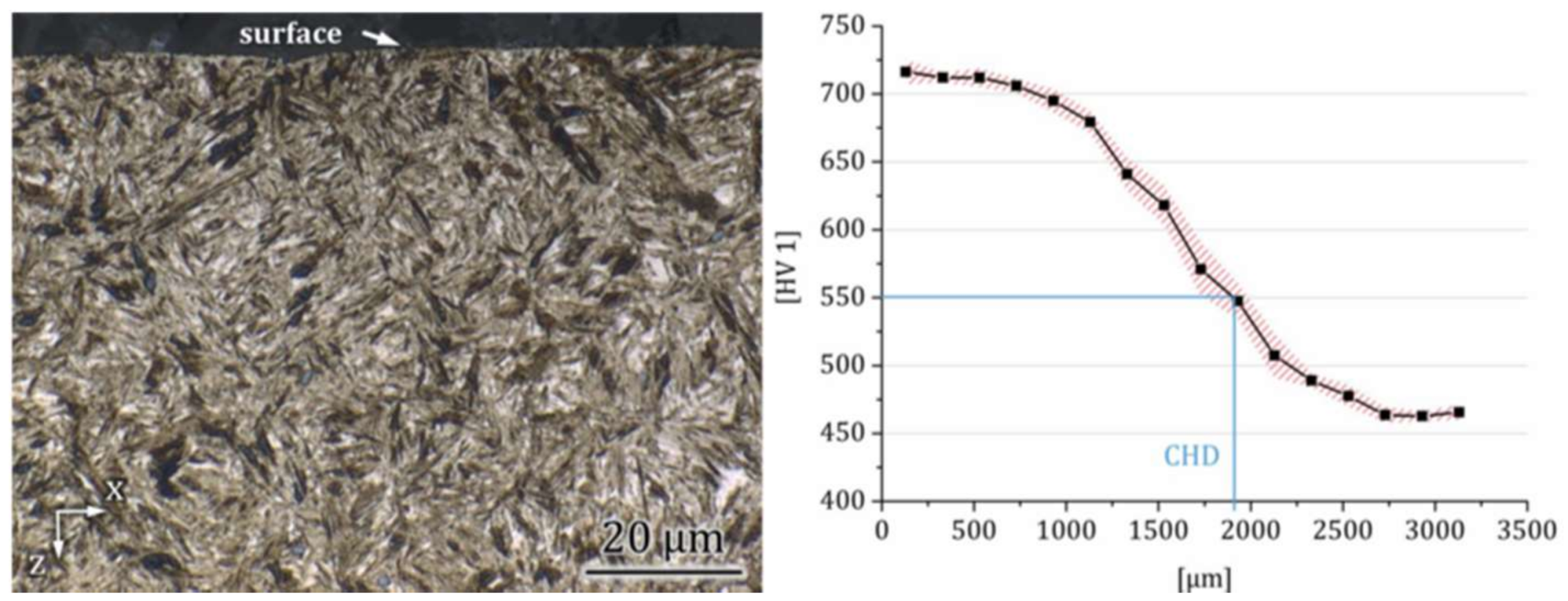


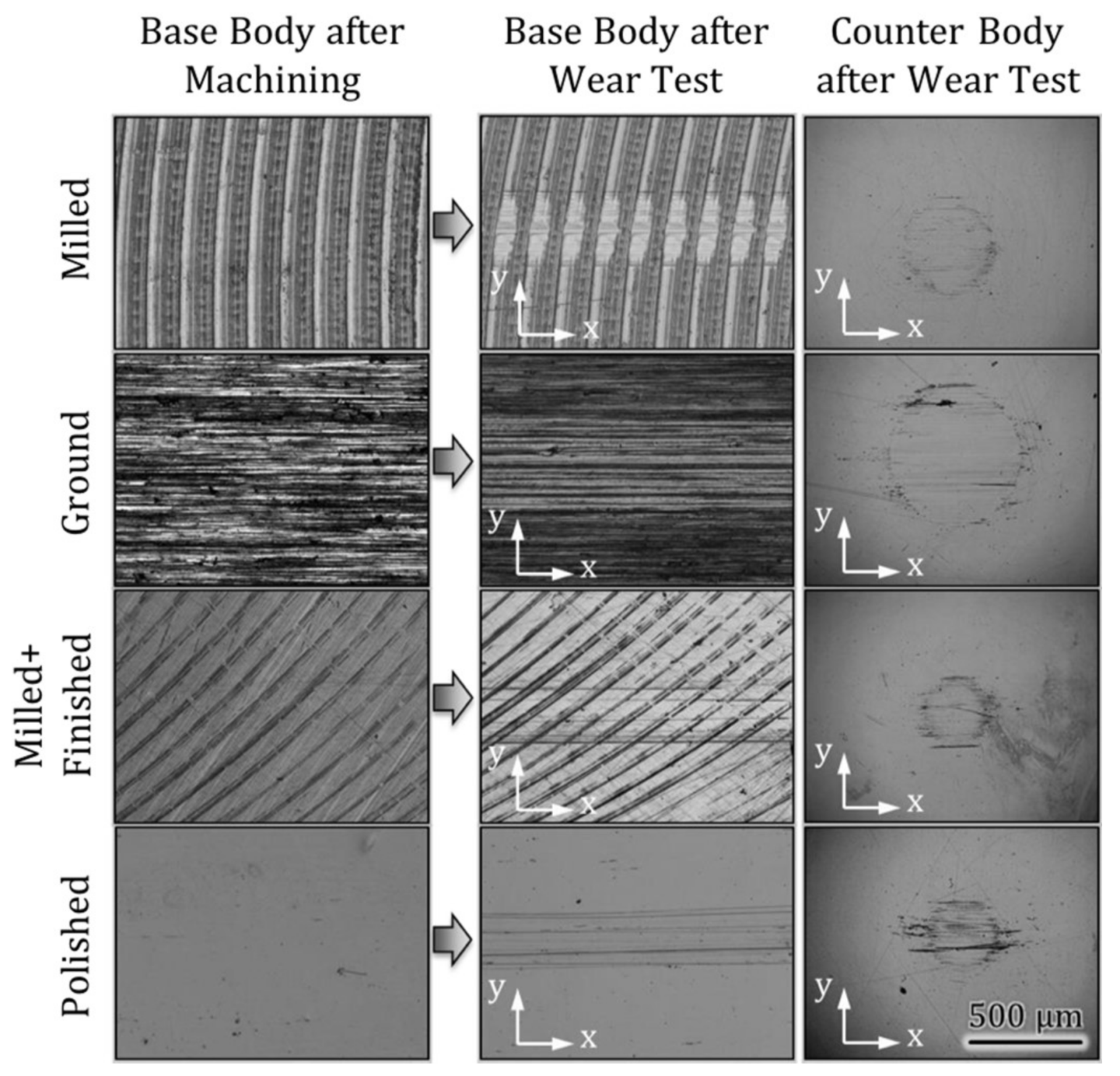
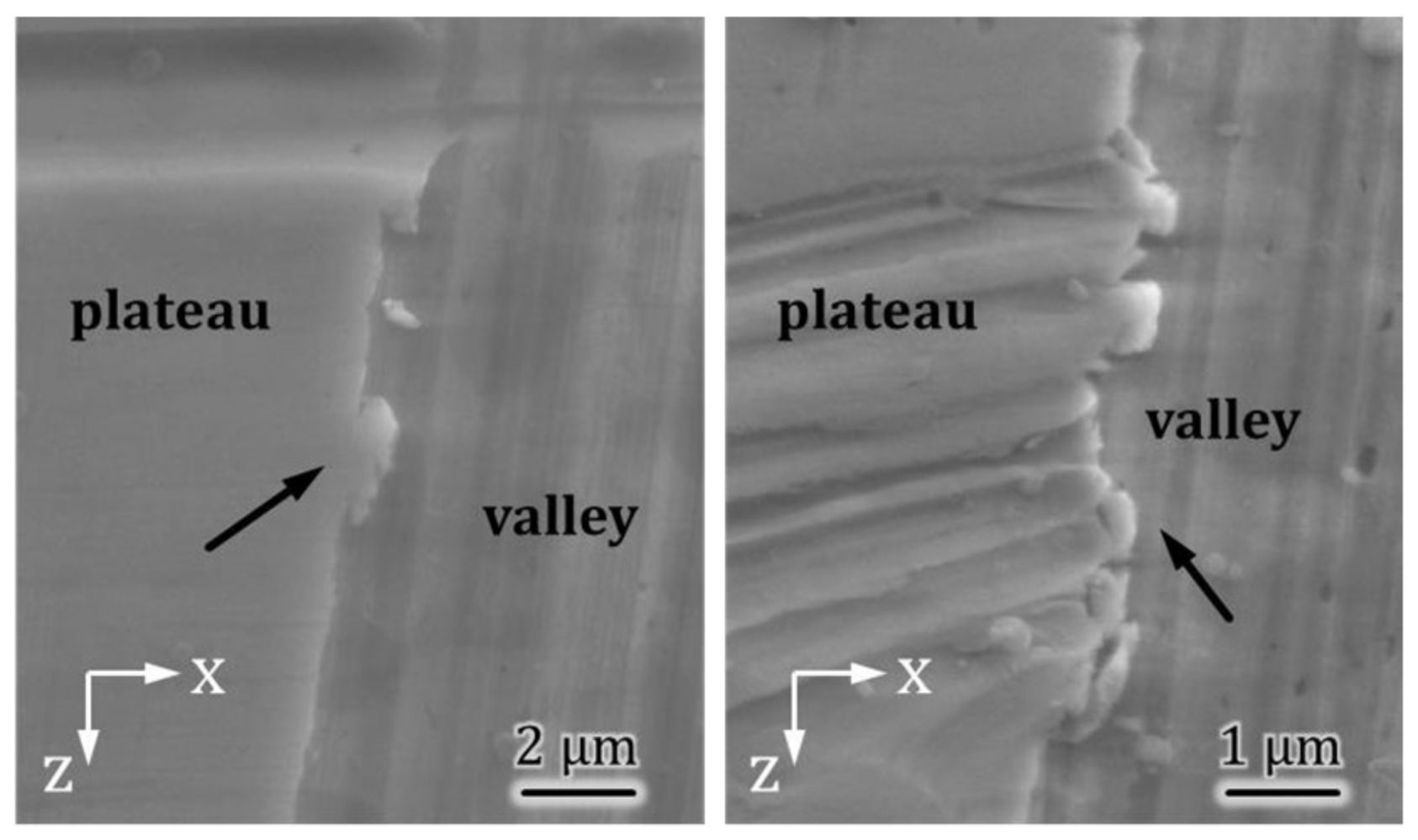
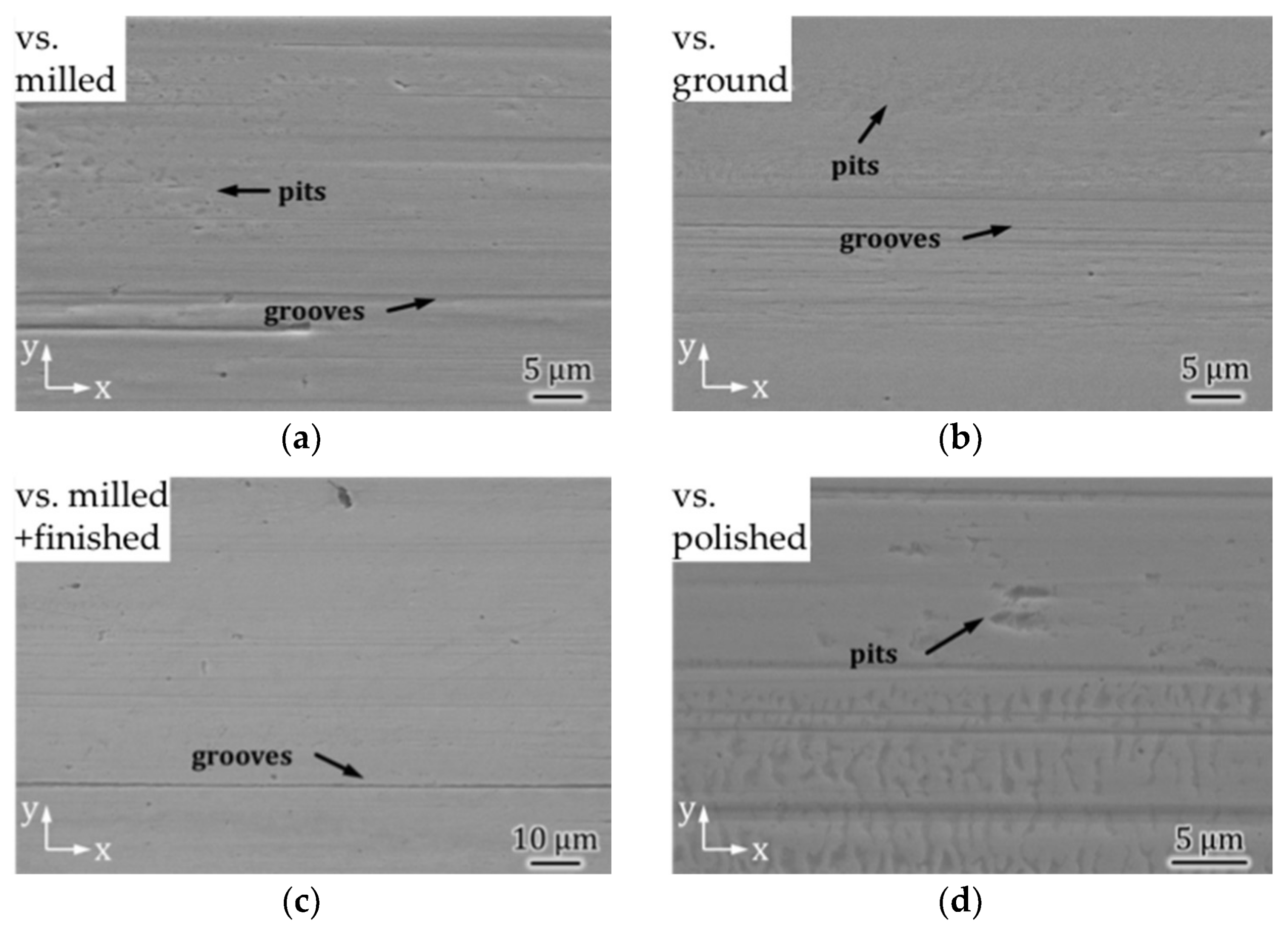
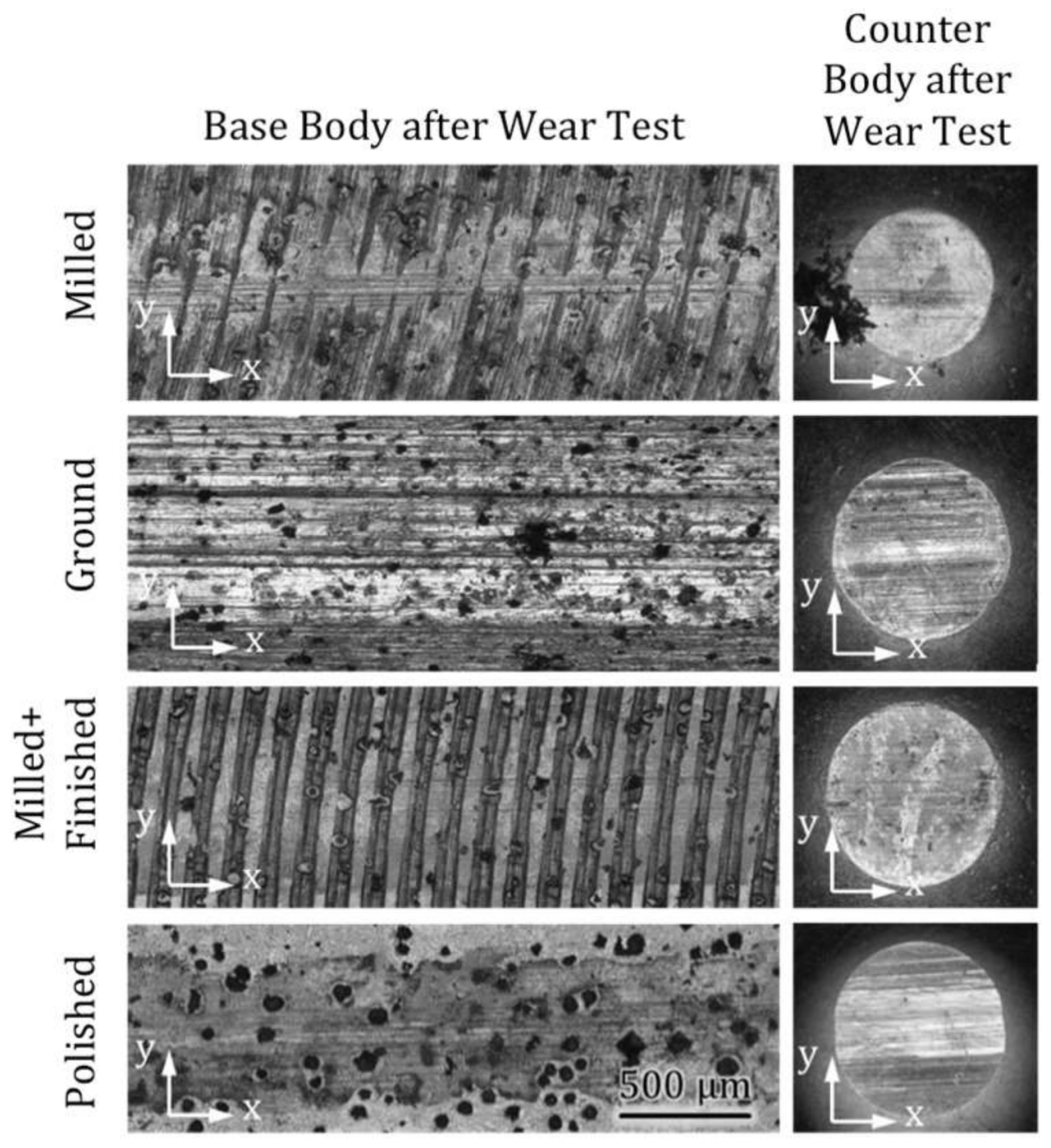
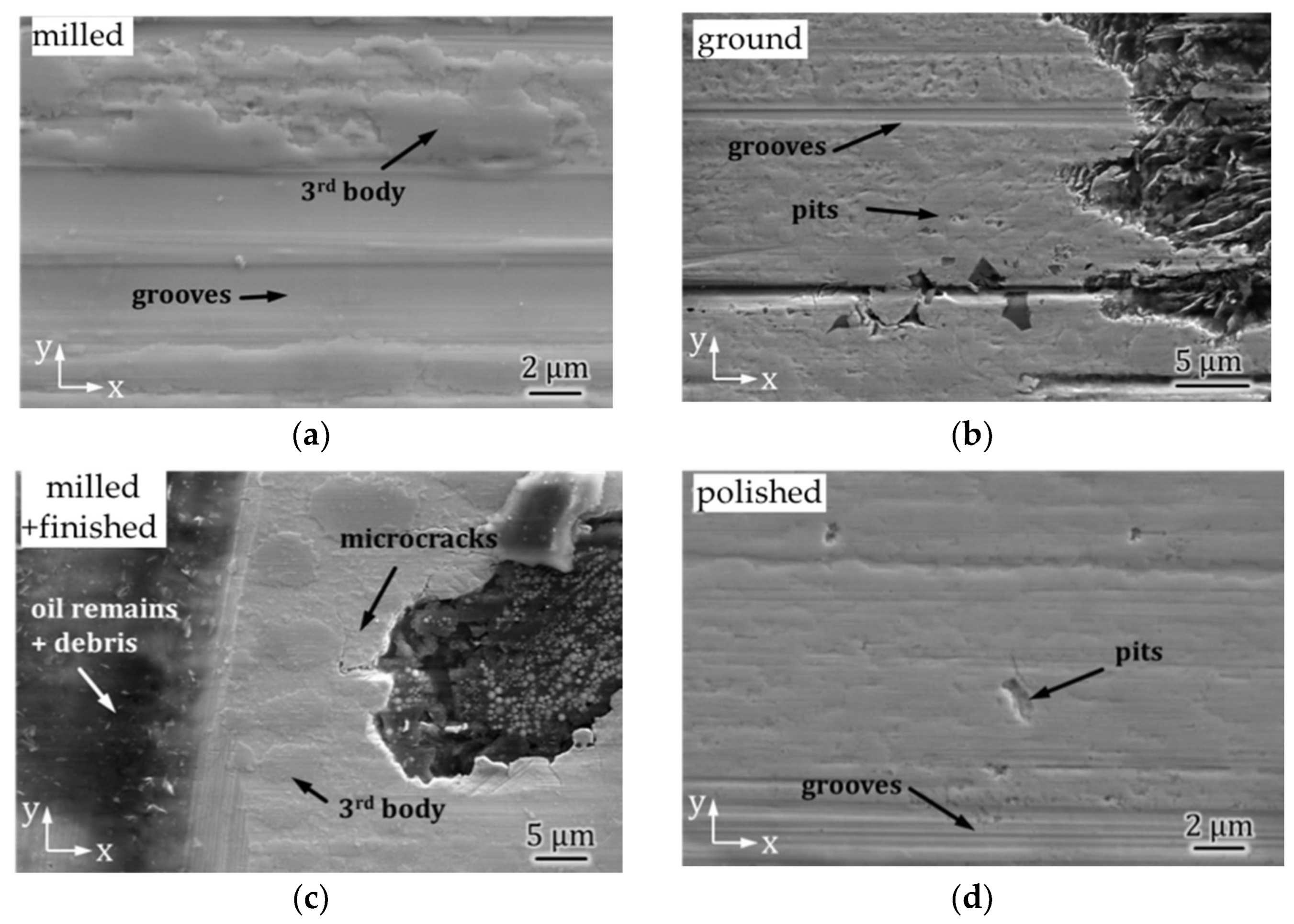
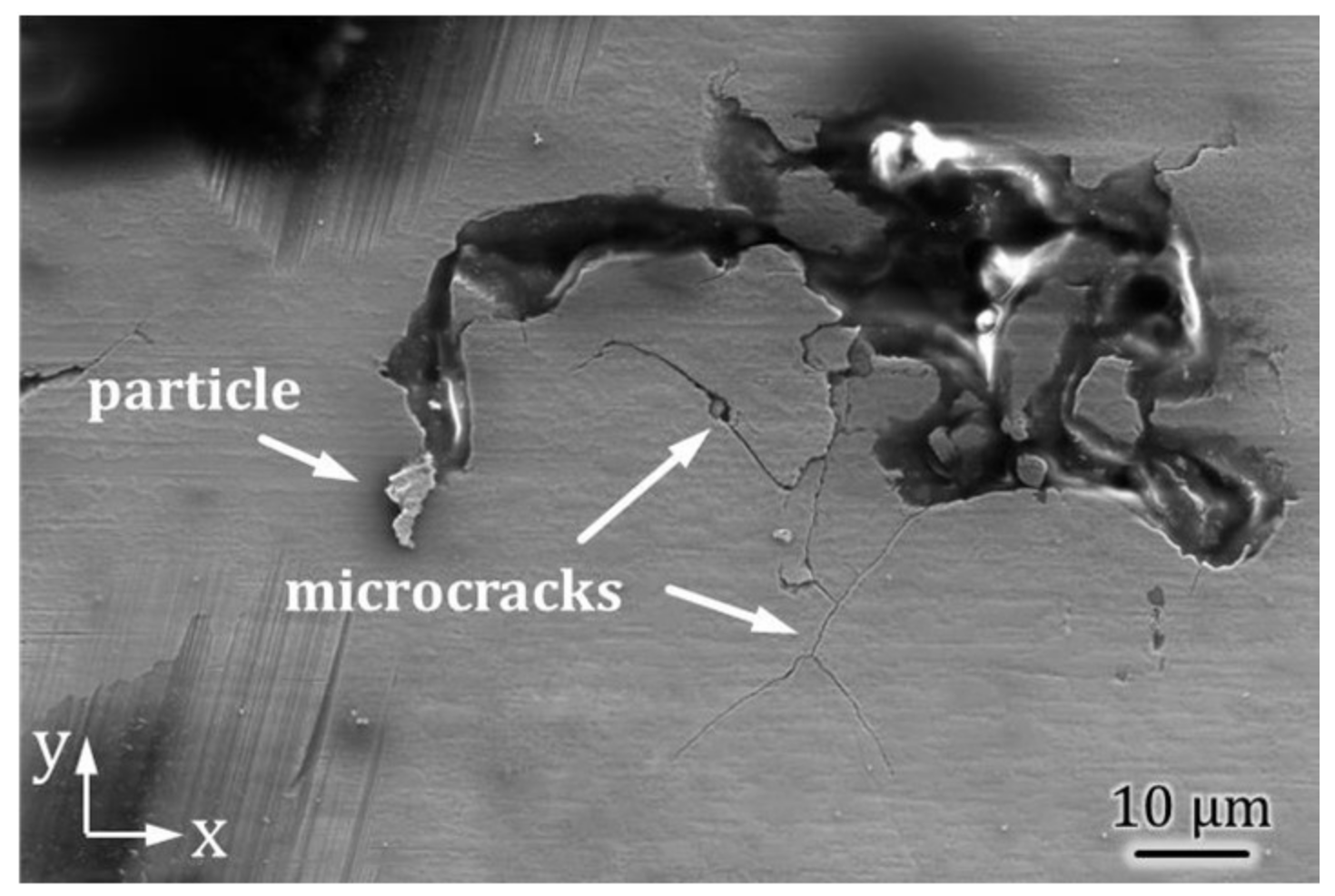
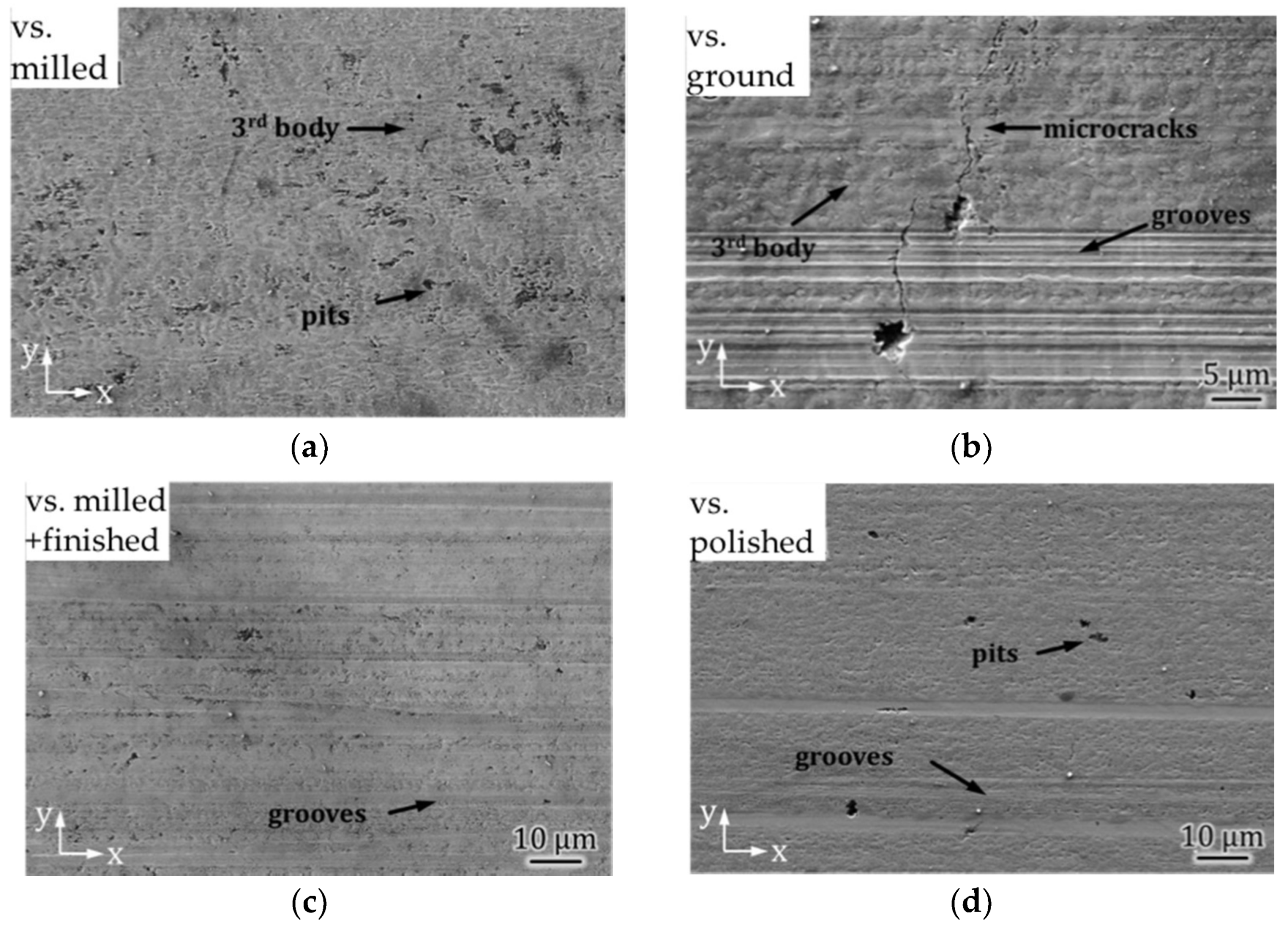

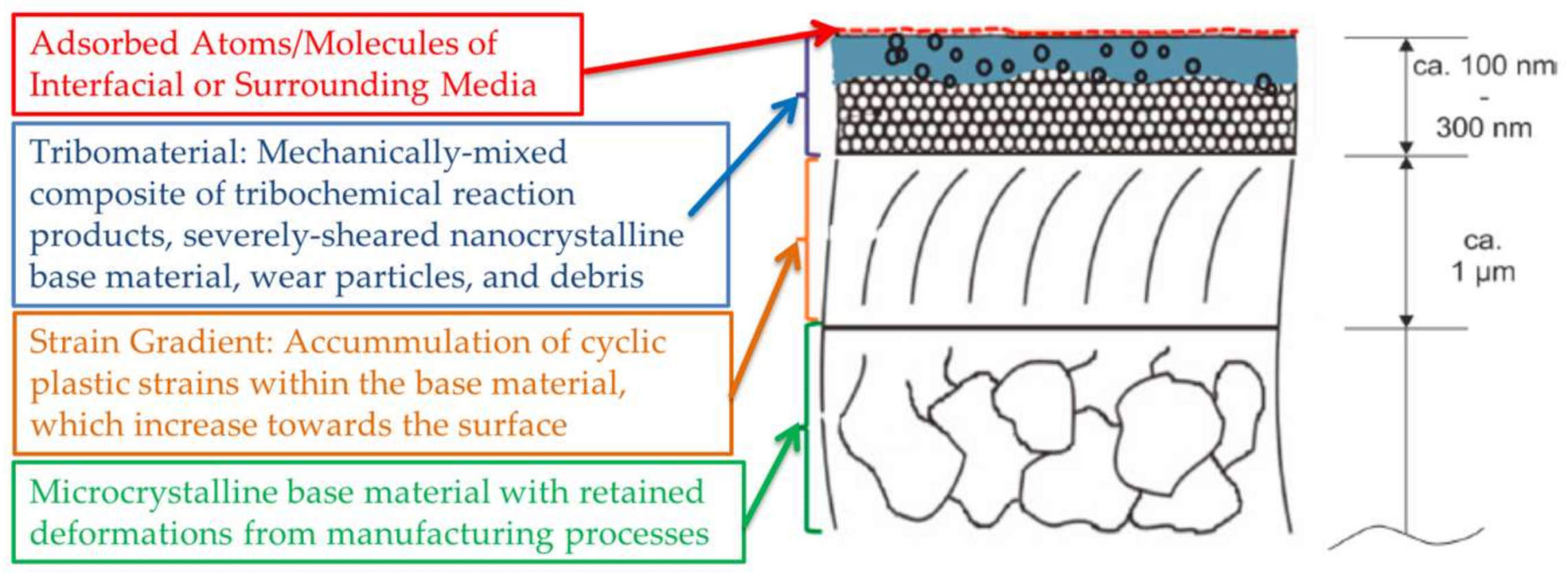
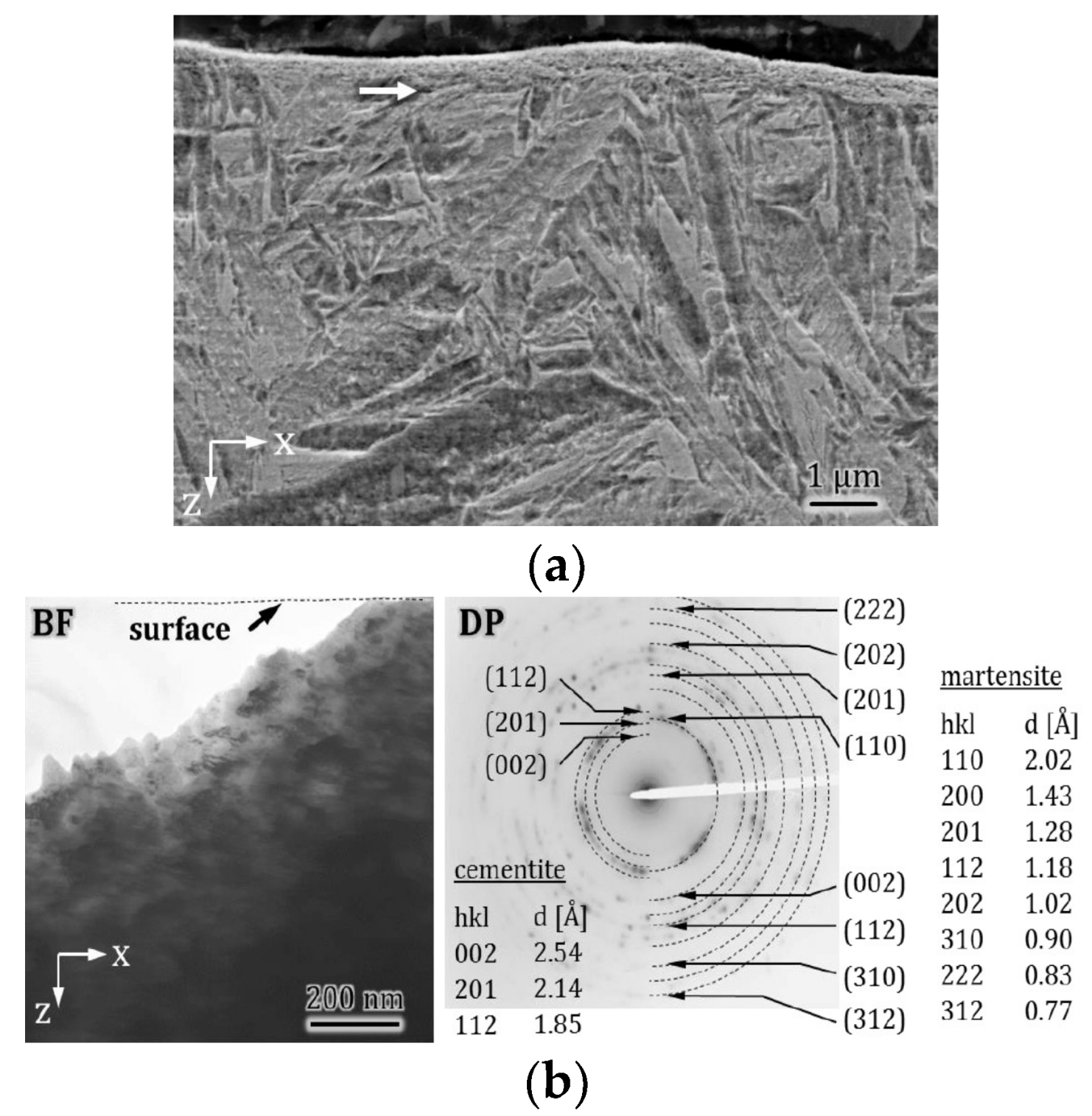

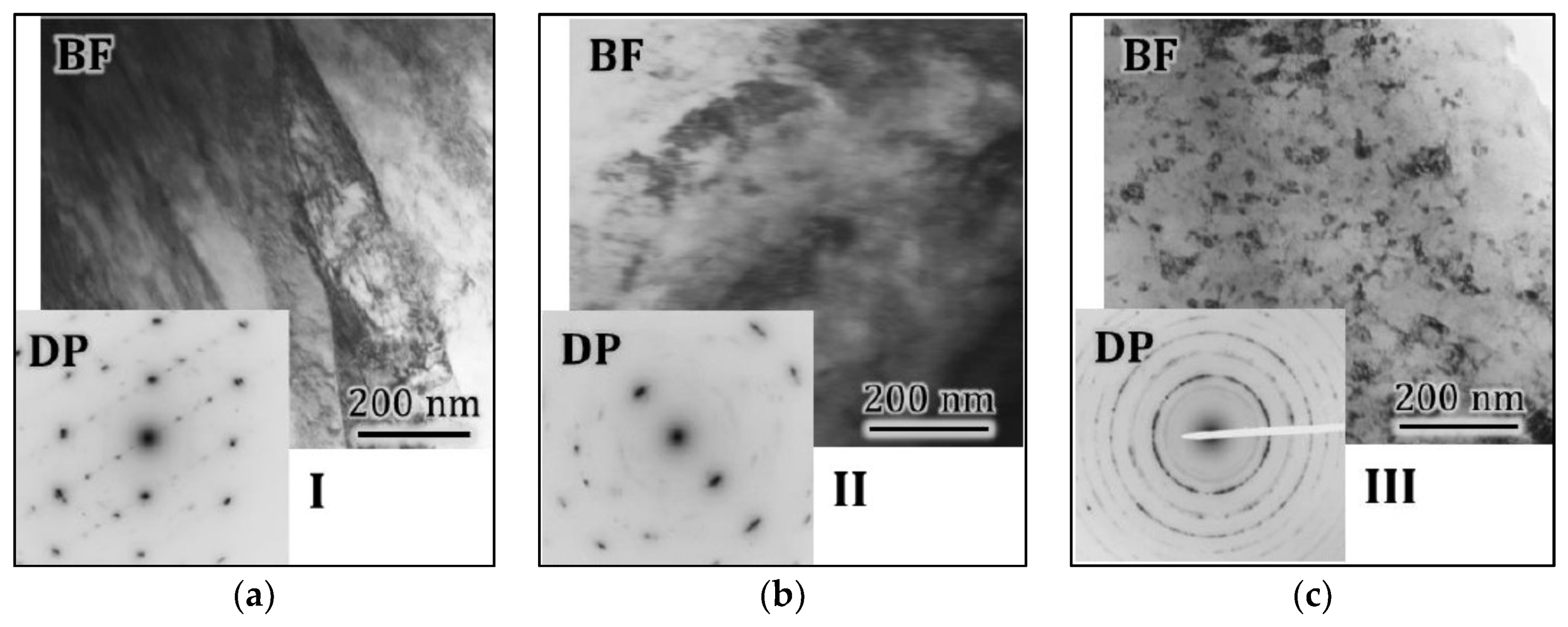
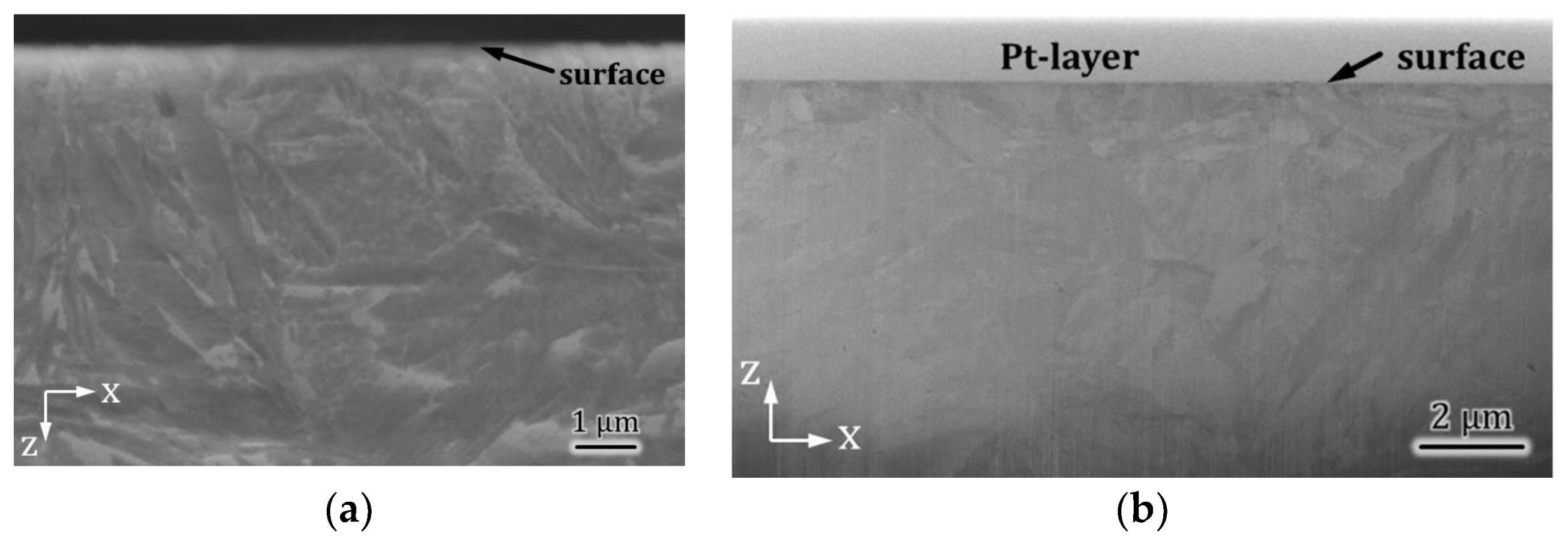
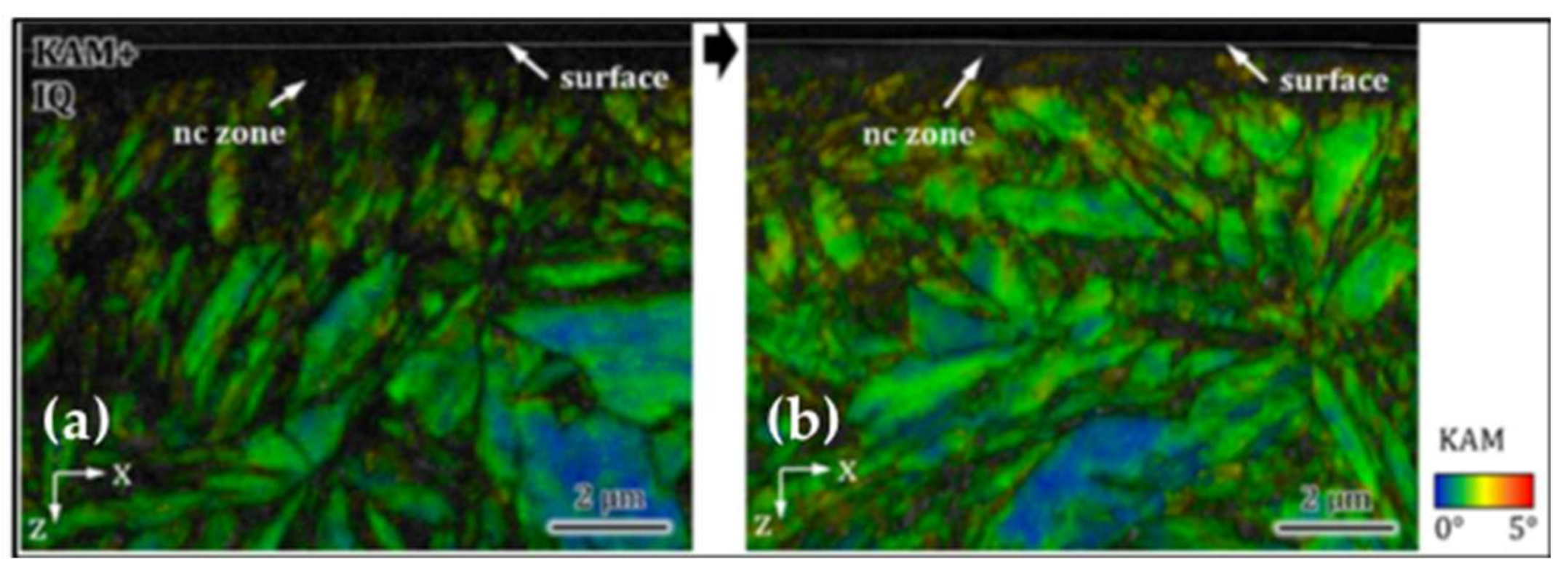

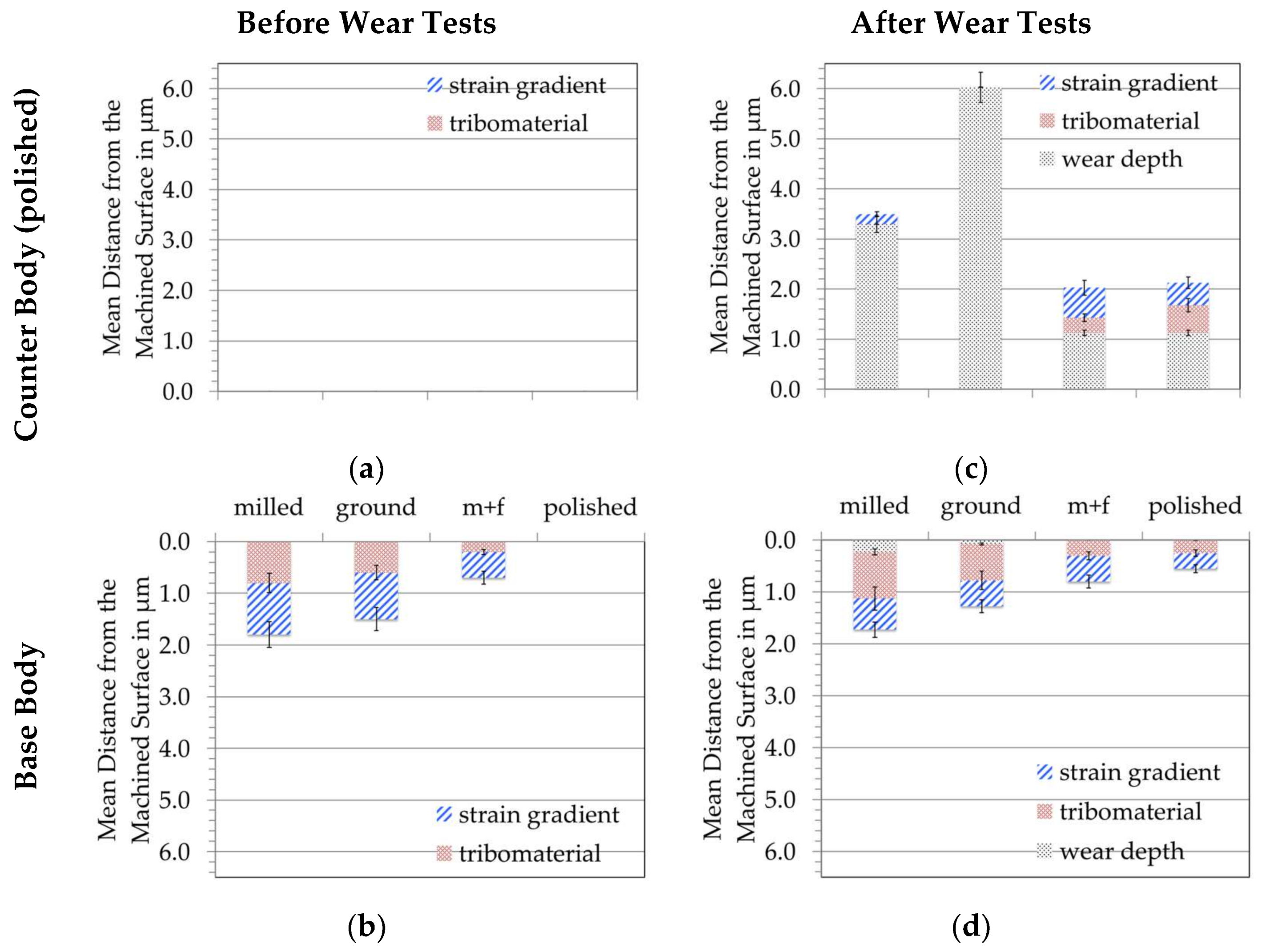
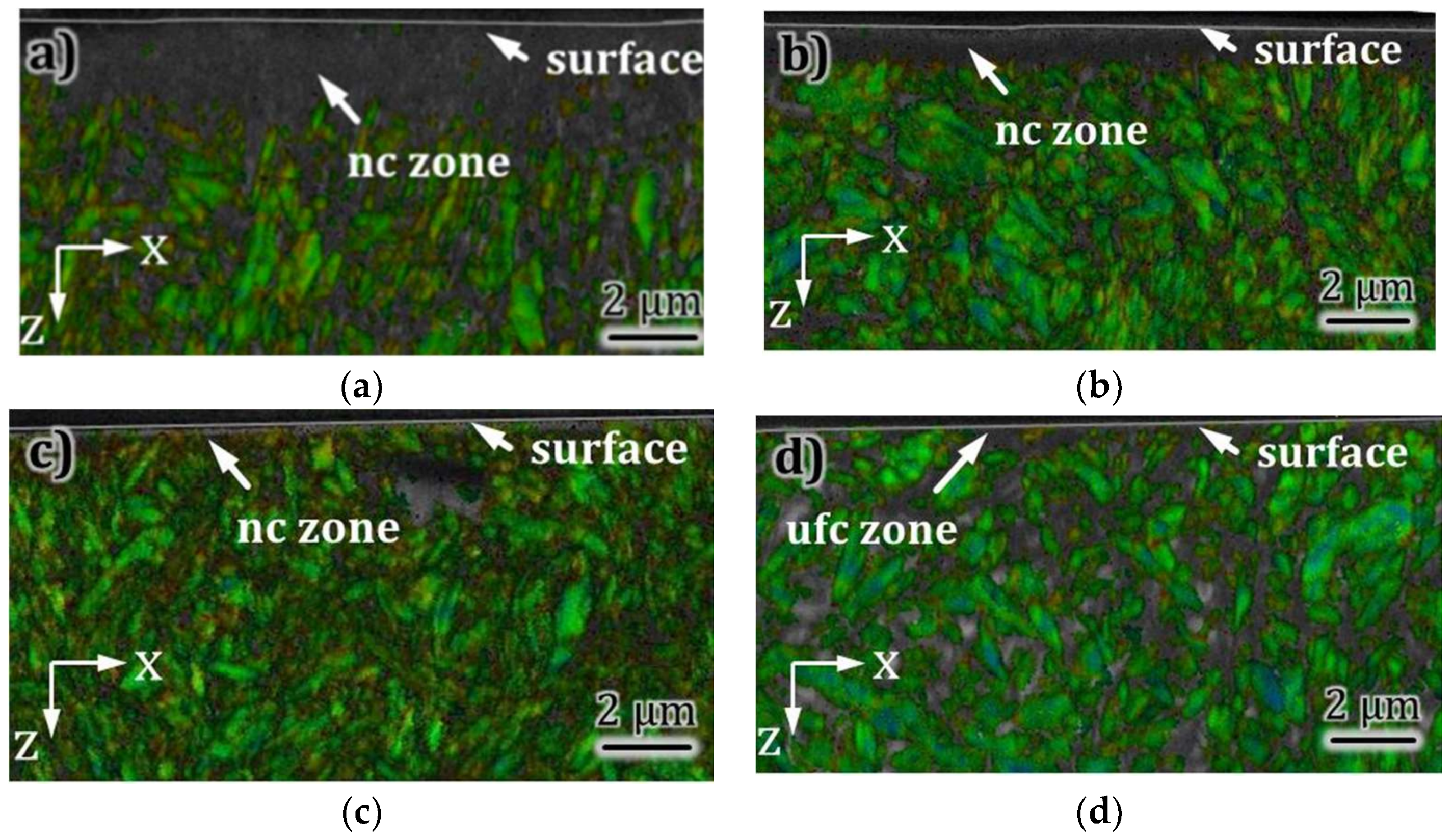
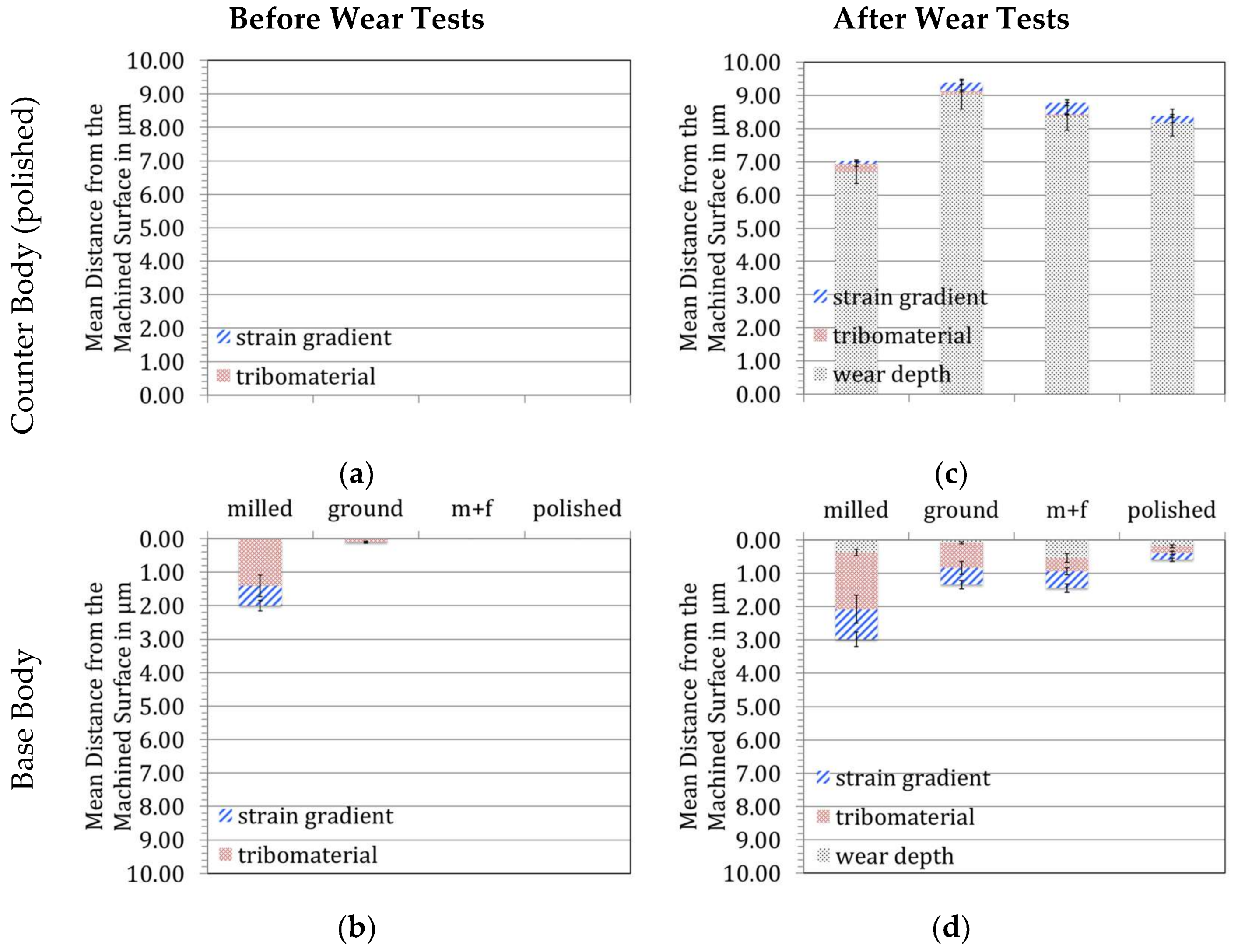
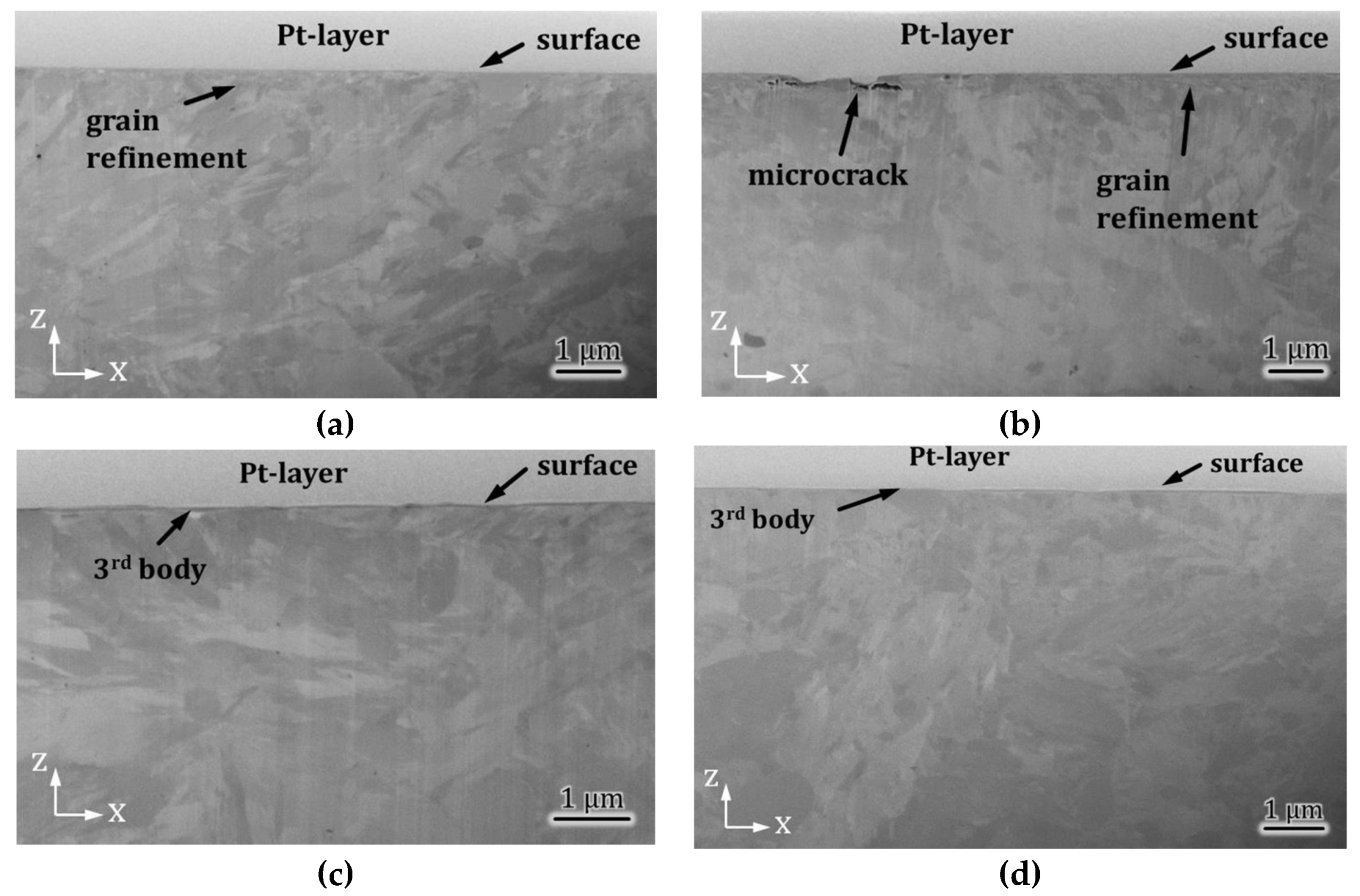
| Tribocouple | CS/CS | CI/BS | |
|---|---|---|---|
| Base Body | Carburized 17CrNiMo7-6 | Flame-hardened EN GJS265HB | |
| Counter Body | Carburized 17CrNiMo7-6 Pin | 100Cr6 Ball | |
| Tip/Ball Radius | mm | 5 | |
| Stroke | mm | 6 | |
| Normal Force | N | 30 | |
| Test Frequency | Hz | 5 | |
| Lubricant | Mobilgear SHC XMP 320 | Mobile 1™ ESP Formula SW-30 | |
| Viscosity at 40 °C | cSt | 320 | 72.8 |
| Lubricant Temperature | °C | 20 | 80 |
| Tribocouple | CS/CS | CI/BS | ||||||||
|---|---|---|---|---|---|---|---|---|---|---|
| Machining | Milled | Ground | m + f | Polished | Milled | Ground | m + f | Polished | ||
| COF | - | 0.084 ± 0.003 | 0.108 ± 0.003 | 0.088 ± 0.0005 | 0.093 ± 0.002 | 0.12 ± 0.0025 | 0.074 ± 0.007 | 0.14 ± 0.0012 | 0.073 ± 0.003 | |
| Ed | kJ | 65 | 81 | 62 | 68 | 88 | 50 | 91 | 50 | |
| WV | BB | ×106 in µm3 | 0.33 | 0.15 | 0.00 | 0.00 | 0.80 | 0.22 | 1.30 | 0.45 |
| CB | 0.17 | 0.57 | 0.02 | 0.02 | 0.70 | 1.28 | 1.10 | 1.05 | ||
| WL | BB | nm/h | 2 | 1 | 0 | 0 | 3 | 1 | 5 | 2 |
| CB | 30 | 54 | 10 | 10 | 60 | 81 | 75 | 74 | ||
| Main Wear Mechanisms | Tribochemical Reactions | Surface Fatigue | Abrasion [35] | Adhesion [40] |
|---|---|---|---|---|
| Submechanisms | Tribooxidation [41] | Delamination (by predominantly elastic interaction of solid contacts [42]) | Microploughing | Material Transfer |
| Tribocorrosion [43] | Indentation (by predominantly plastic interaction of solid contacts [37]) | Microcutting | ||
| Mechanical Mixing [44] | Microcracking | |||
| Microfatigue |
© 2018 by the authors. Licensee MDPI, Basel, Switzerland. This article is an open access article distributed under the terms and conditions of the Creative Commons Attribution (CC BY) license (http://creativecommons.org/licenses/by/4.0/).
Share and Cite
Stemmer, P.; Fischer, A. Pathways of Dissipation of Frictional Energy under Boundary Lubricated Sliding Wear of Martensitic Materials. Lubricants 2018, 6, 34. https://doi.org/10.3390/lubricants6020034
Stemmer P, Fischer A. Pathways of Dissipation of Frictional Energy under Boundary Lubricated Sliding Wear of Martensitic Materials. Lubricants. 2018; 6(2):34. https://doi.org/10.3390/lubricants6020034
Chicago/Turabian StyleStemmer, Priska, and Alfons Fischer. 2018. "Pathways of Dissipation of Frictional Energy under Boundary Lubricated Sliding Wear of Martensitic Materials" Lubricants 6, no. 2: 34. https://doi.org/10.3390/lubricants6020034





